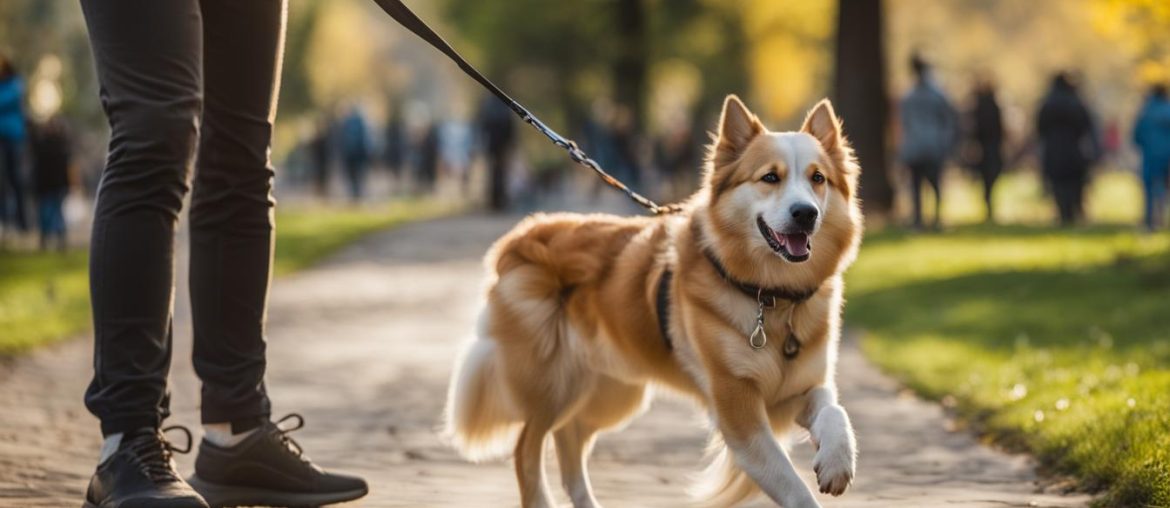Teaching a dog to walk on a leash without pulling is an essential skill that every dog owner should work on. It can be challenging, but with patience and consistency, you can achieve success. In this article, I will explore effective techniques to teach your dog to walk nicely on a leash without pulling, focusing on the concept of loose leash walking.
Key Takeaways:
- Leash training is important for safety and control during walks.
- Choosing the right leash walking equipment can make a big difference.
- The stop and reward method is an effective technique for leash training.
- Consistency and positive reinforcement are key to overcoming pulling and distractions.
- Reward-based training strengthens the bond between you and your dog.
The Importance of Leash Training for Dogs
Leash training is a crucial aspect of dog ownership that should not be overlooked. Not only does it ensure the safety of your canine companion, but it also contributes to a more enjoyable and controlled walking experience for both of you. By teaching your dog to walk on a leash without pulling, you can establish yourself as the leader and strengthen the bond between you and your furry friend.
One of the primary reasons leash training is important is for your dog’s safety. By keeping them on a leash, you can prevent them from running into dangerous situations such as busy roads or encounters with aggressive animals. Leash training also allows you to have better control over your dog, preventing them from wandering off, getting into mischief, or bothering other people or pets. It gives you the ability to keep them close and focused on the task at hand, whether it’s a casual stroll around the neighborhood or a more rigorous outdoor adventure.
Leash training is not only beneficial for your dog’s safety but also for their overall behavior and obedience. When you teach your dog to walk on a leash without pulling, you are establishing yourself as the leader in the relationship. This helps to create a sense of trust and respect between you and your dog, which can translate into other areas of their training and behavior. By consistently reinforcing the desired behavior of loose leash walking, you are setting a foundation for good manners and obedience both on and off the leash.
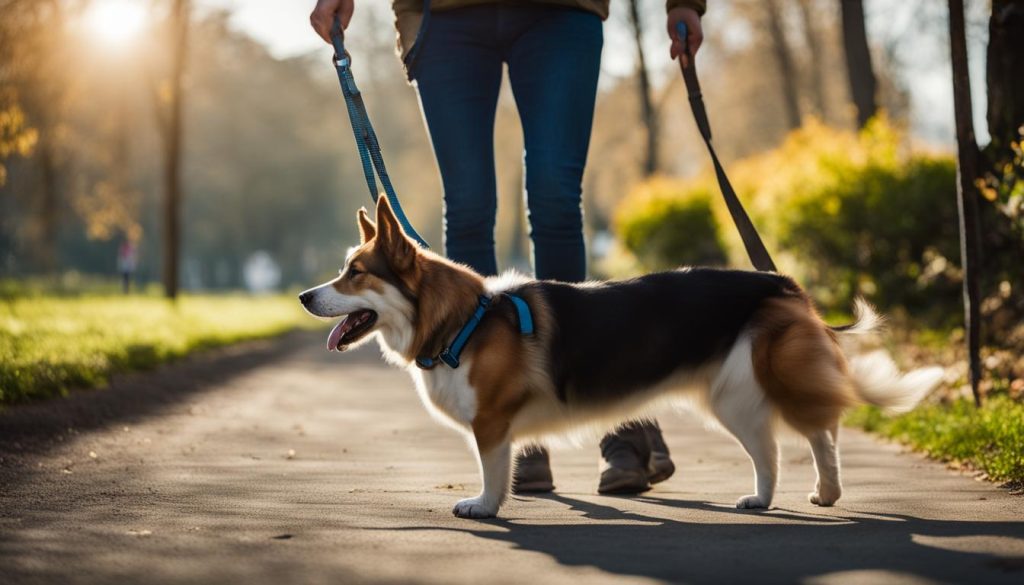
The Importance of Leash Training for Dogs – Key Points:
- Leash training ensures the safety of your dog and prevents them from running into dangerous situations.
- It provides a more enjoyable and controlled walking experience for both you and your dog.
- Leash training helps establish you as the leader and strengthens the bond with your furry friend.
- It contributes to your dog’s overall behavior and obedience, creating a foundation for good manners.
Quote:
“Leash training is an essential skill that every dog owner should prioritize. It not only keeps your dog safe, but it also helps build a strong bond and establishes your role as the leader in the relationship.” – [Your Name]
Table: Comparing the Benefits of Leash Training
| Benefits | Leash Training | No Leash Training |
|---|---|---|
| Ensures safety | ✓ | ✘ |
| More enjoyable walks | ✓ | ✘ |
| Establishes leadership | ✓ | ✘ |
| Improves behavior | ✓ | ✘ |
Choosing the Right Leash Walking Equipment
When it comes to leash walking, choosing the right equipment for your dog is essential. The right gear can make a significant difference in your dog’s training progress and overall walking experience. Here are some important factors to consider when selecting the right leash walking equipment:
- Comfort: I highly suggest that you choose equipment that is comfortable for your dog to wear. Look for materials that are soft and non-restrictive, such as padded harnesses or gentle leader head collars. The more comfortable your dog is, the more likely they will be to cooperate during walks.
- Control: The equipment you choose should provide you with better control over your dog’s movements. For dogs that tend to pull, consider using a front-attachment harness or a head collar. These options discourage pulling and allow you to redirect your dog’s attention back to you.
- Safety: Ensure that the equipment you choose does not cause any harm or discomfort to your dog. Avoid using choke chains, prong collars, or any other harsh devices. Instead, opt for humane options that promote positive reinforcement-based training methods.
Don’t forget that each dog is unique, and what works for one may not work for another, so it may be necessary to try out a few different options to find the right fit. Consulting with a professional dog trainer can also provide valuable guidance in selecting the most suitable leash walking equipment for your dog’s specific needs.
| Pros | Cons |
|---|---|
| Provides better control over your dog | May take some time for your dog to get used to wearing the equipment |
| Comfortable for your dog to wear | May not be effective for all dogs, as some may still pull despite the equipment |
| Does not cause harm or discomfort to your dog | May require some trial and error to find the right equipment that works for your dog |
Choosing the right leash walking equipment is an important step in the training process. It can make the difference between a frustrating walk and an enjoyable one. Take the time to research and select equipment that meets your dog’s needs, and remember to always prioritize their comfort and safety. With the right gear and consistent training, you’ll be well on your way to leash walking success.

The Stop and Reward Method
The stop and reward method is a simple yet effective technique for leash training. When your dog pulls on the leash, you stop moving forward and wait for them to come back to your side. Once they are walking nicely by your side, you reward them with treats or praise. This method helps to reinforce the desired behavior of walking without pulling.
To implement the stop and reward method effectively, start by establishing a clear cue to let your dog know when they are pulling. It can be a simple word like “wait” or a gentle tug on the leash. When your dog pulls, immediately stop in your tracks and stand still. Avoid yanking the leash or jerking it back, as this can cause discomfort and confusion. Wait for your dog to release tension on the leash and come back to your side. Once they do, reward them with their favorite treats or enthusiastic praise.
Consistency is key when using the stop and reward method. Practice this technique during every walk and make sure everyone involved in your dog’s training follows the same approach. Over time, your dog will learn that pulling on the leash does not lead to progress, while walking calmly by your side is rewarded and enjoyable.
Common Challenges and Solutions
Implementing the stop and reward method may come with some challenges. Here are a few common issues that dog owners may encounter and some solutions:
- Persistence: It takes time for your dog to understand the desired behavior. Be patient and consistent with the stop and reward method, even if progress seems slow at first.
- Distractions: Dogs are naturally curious and may get easily distracted during walks. If your dog starts pulling due to a distraction, use the stop and reward method to regain their attention and bring them back to walking nicely by your side.
- Treat Motivation: If your dog is not motivated by treats, you can use toys, playtime, or other rewards that they find enjoyable. Experiment to find what motivates your dog the most.
To put it simply, leash training takes time and patience. By using the stop and reward method consistently and addressing any challenges along the way, you can teach your dog to walk nicely on a leash without pulling.

Step-by-Step Guide to Leash Training a Puppy
Leash training a puppy requires patience and consistency. You should start the training process early to establish good habits. Here is a step-by-step guide to help you teach your puppy to walk nicely on a leash:
1. Introduce the leash
Start by introducing your puppy to the leash in a calm and positive manner. Allow them to sniff and explore the leash before attaching it to their harness. Gradually increase the amount of time your puppy spends wearing the leash to help them get used to the feeling.
2. Practice in a familiar environment
Begin training in a quiet and familiar outdoor area with minimal distractions. This will help your puppy stay focused and make the training process smoother. Use treats or toys to encourage your puppy to walk beside you on the leash. Reward them with praise and rewards when they exhibit the desired behavior of walking without pulling.
3. Gradually increase the distance
Once your puppy is comfortable walking on a leash in a familiar environment, slowly start introducing new environments and distractions. Gradually increase the distance of your walks and expose your puppy to different sights, sounds, and smells. This will help them become more confident and well-behaved on walks.
4. Be consistent and patient
Consistency and patience are key when leash training a puppy. Don’t forget that puppies have short attention spans, so keep training sessions short and frequent. Practice leash walking regularly to reinforce good habits and ensure your puppy becomes proficient in walking on a leash without pulling.
By following these steps and being consistent in your training efforts, you can successfully leash train your puppy and enjoy pleasant walks together.
| Benefits of Leash Training a Puppy | Training Tips |
|---|---|
| – Ensures safety during walks | – Keep training sessions short and frequent |
| – Provides control in different environments | – Use positive reinforcement and rewards |
| – Strengthens the bond between you and your puppy | – Gradually increase the difficulty of training |
| – Establishes good walking manners | – Practice in various environments |
Try to always prioritize positive reinforcement and rewards when training your puppy. With time and consistency, your puppy will become a well-behaved and enjoyable walking companion.
Dealing with Pulling and Distractions
When it comes to leash training, dealing with pulling and distractions can be a common challenge. Dogs may pull on the leash due to excitement or being enticed by something in their environment. However, with the right techniques and consistent training, you can help your dog overcome these behaviors and improve their leash walking skills.
One effective method to address pulling is to change direction or stop when your dog starts pulling on the leash. This helps to get their attention and encourages them to come back to your side. By rewarding them when they walk without pulling, you reinforce the desired behavior of walking nicely on the leash.
In addition to addressing pulling, work on managing distractions during walks. Start by practicing in a familiar and controlled environment, gradually increasing the level of distractions. This could include encountering other dogs, people, or enticing smells. By gradually exposing your dog to distractions and rewarding them for maintaining focus on you, you can help them stay engaged and walk calmly on the leash.
Consistency and positive reinforcement are key when dealing with pulling and distractions. Set clear expectations for your dog and reinforce good behaviors with treats, praise, or toys. Be patient and understanding as your dog learns and grows, and remember that every walk is an opportunity for improvement.
| Common Challenges | Techniques to Overcome |
|---|---|
| Pulling on the leash | – Change direction or stop when your dog pulls – Reward them for walking without pulling |
| Distractions during walks | – Gradually introduce distractions – Reward your dog for maintaining focus on you |
| Lack of consistency | – Set clear expectations for your dog – Reinforce good behaviors consistently – Be patient and understanding |

To put it simply, leash training takes time and effort, but the results are well worth it. By addressing pulling and managing distractions, you can help your dog become a well-behaved and enjoyable walking companion. Stay consistent, patient, and always reward good behavior. Happy walking!
Tips for Distraction-Proofing Your Dog on Walks
Distraction-proofing your dog during walks is essential to ensure they stay focused and well-behaved. Here are some tips to help you minimize distractions and keep your dog on track:
Create a Structured Routine
Establishing a consistent routine can help your dog understand what is expected of them during walks. Set specific times for walks and stick to them. This will help your dog anticipate their walking sessions and be prepared to focus on you.
Start in a Controlled Environment
When initially working on distraction-proofing, start in a controlled and familiar environment, such as your backyard or a quiet park. Gradually introduce distractions, such as other dogs or people, as your dog becomes more comfortable and responsive to your commands.
Use High-Value Rewards
Bring along high-value treats or toys that your dog finds especially rewarding. Use these rewards to reinforce good behavior and keep your dog’s attention on you during walks. By associating positive experiences with staying focused, your dog will be more motivated to resist distractions.
Practice Focus Exercises
Teach your dog specific focus exercises to redirect their attention back to you when they become distracted. For example, you can train them to make eye contact with you on command or to respond to a specific sound. Practice these exercises regularly, gradually increasing the difficulty level by adding distractions.
| Tips for Distraction-Proofing Your Dog on Walks | |
|---|---|
| Create a Structured Routine | Establish a consistent walking schedule to help your dog anticipate their walks and be ready to focus. |
| Start in a Controlled Environment | Begin training in a familiar and quiet environment, gradually introducing distractions as your dog progresses. |
| Use High-Value Rewards | Bring along rewards that your dog finds especially enticing to reinforce good behavior and maintain focus. |
| Practice Focus Exercises | Teach your dog specific exercises to redirect their attention back to you when distractions arise during walks. |
To put it simply, distraction-proofing takes time and patience. Stay consistent with your training efforts, and celebrate every small progress your dog makes. With practice and positive reinforcement, your dog will become more reliable and focused during walks, making the experience enjoyable for both of you.

Using Reward-Based Training for Leash Walking
Teaching your dog to walk on a leash without pulling can be a rewarding experience for both you and your furry friend. One of the most effective and humane methods for achieving this is through reward-based training. By using positive reinforcement, you can encourage your dog to exhibit the desired behavior of walking nicely on a leash.
When using reward-based training, have treats, praise, or toys that your dog finds motivating. Start by walking with your dog on a loose leash, and as soon as they walk beside you without pulling, reward them with a treat and verbal praise. This positive reinforcement helps your dog associate walking calmly on a leash with a positive experience.
I recommend that you consistently reward your dog for good leash walking behavior and to ignore any unwanted pulling or lunging. By redirecting your dog’s attention back to walking calmly and rewarding them for doing so, you reinforce the behavior you want to see. Over time, your dog will learn that walking nicely on a leash brings rewards, making them more likely to repeat the desired behavior.
Tips for Using Reward-Based Training:
- Use high-value treats that your dog loves to motivate them during training sessions.
- Be consistent with your rewards and reinforce good behavior every time your dog walks nicely on a leash.
- Start training in a quiet, low-distraction environment and gradually increase the level of distractions as your dog becomes more proficient.
- If your dog starts to pull or exhibit unwanted behavior, calmly stop walking and wait for them to refocus on you. Once they do, resume walking and reward them for their attention.
To put it simply, using reward-based training for leash walking not only helps teach your dog good manners but also strengthens the bond between you and your pet. It’s a positive and enjoyable way to teach your dog to walk nicely on a leash without pulling, making your walks together a pleasant experience for both of you.

The Role of Equipment in Leash Training
When it comes to leash training for dogs, the right equipment can make all the difference. Choosing the right tools can help to stop a dog from pulling on the leash and improve their overall walking behavior. I recommend that you select equipment that is both effective and safe for your furry friend.
The Right Leash and Harness
The most commonly used equipment for leash training is a standard leash and harness. A leash with a length of 4 to 6 feet provides optimal control while giving your dog some freedom to explore. Opt for a flat or martingale collar to avoid putting excessive pressure on your dog’s neck. Harnesses are great alternatives to collars, especially for dogs prone to pulling. Front-attachment harnesses or head collars can help discourage pulling by redirecting your dog’s attention towards you.
Avoid Harsh Training Tools
certain training tools, such as choke chains or prong collars, can have adverse effects on your dog’s behavior and well-being. These harsh methods may cause physical pain and can lead to fear or aggression. Stick to positive reinforcement techniques and reward-based training instead.
| Equipment | Description |
|---|---|
| Standard Leash | A leash with a length of 4 to 6 feet for optimal control. |
| Flat or Martingale Collar | Avoid excessive pressure on your dog’s neck. |
| Front-Attachment Harness | Redirects your dog’s attention and discourages pulling. |
| Head Collar | Provides excellent control and redirection. |
Consistency is Key
Don’t forget that equipment alone is not a magic solution for leash training. Consistency, patience, and positive reinforcement are equally important. Take the time to familiarize your dog with the equipment gradually and ensure it fits properly. Use rewards, praise, and treats to reinforce desired behaviors, such as walking without pulling. With the right equipment and training techniques, you can set your dog up for success in their leash training journey.
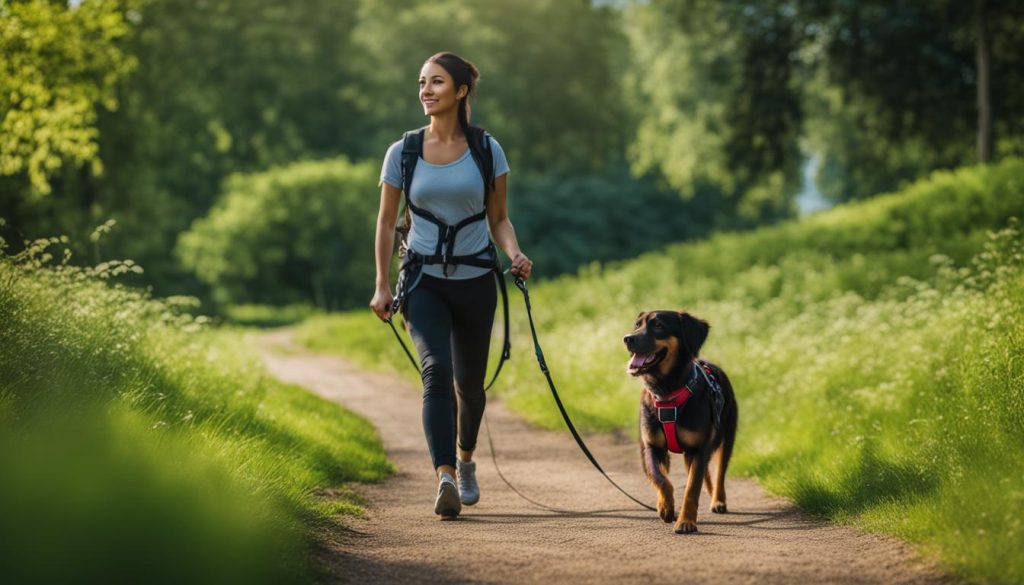
To put it simply, every dog is different, so I would advise that you find the equipment that works best for your four-legged companion. Choose equipment that is comfortable, safe, and effective in helping you achieve loose leash walking. With the right tools and proper training, you can enjoy peaceful, enjoyable walks with your furry friend by your side.
Training Your Dog to Heel
Teaching your dog to heel is a valuable skill that enhances control and responsiveness during walks. Heel training involves teaching your dog to walk closely by your side, maintaining a specific position. By following these dog training tips, you can successfully teach your furry friend to heel on a leash.
Establishing a Foundation
Before starting heel training, ensure that your dog has a good understanding of loose leash walking. This foundation skill encourages your dog to walk calmly by your side without pulling. Once your dog consistently walks nicely on a loose leash, you can begin introducing the concept of heel.
Start by using a verbal cue, such as “heel” or “close,” and reinforce your dog for walking in the desired position. Use treats, toys, or verbal praise as rewards for maintaining the correct heel position. Be patient and consistent in your training, gradually increasing the duration and distance your dog walks in the heel position.
Using Visual Prompts
In addition to verbal cues, visual prompts can help reinforce the heel position. Hold a treat or toy close to your body, near your dog’s nose, to encourage them to stay by your side. You can also use your hand or a target stick to guide your dog into the correct position. Consistent use of visual prompts will help your dog understand the desired behavior and reinforce the heel position.
Practicing in Different Environments
Once your dog understands the concept of heel, practice in various environments. Start in a quiet and familiar area, gradually increasing the level of distractions as your dog becomes more proficient. Practice in different environments, such as parks or busy streets, to ensure that your dog remains focused and obedient during walks.
Try to always use positive reinforcement and reward your dog for walking in the heel position. Consistency, patience, and regular practice will help your dog develop the skills needed to heel effectively on a leash.
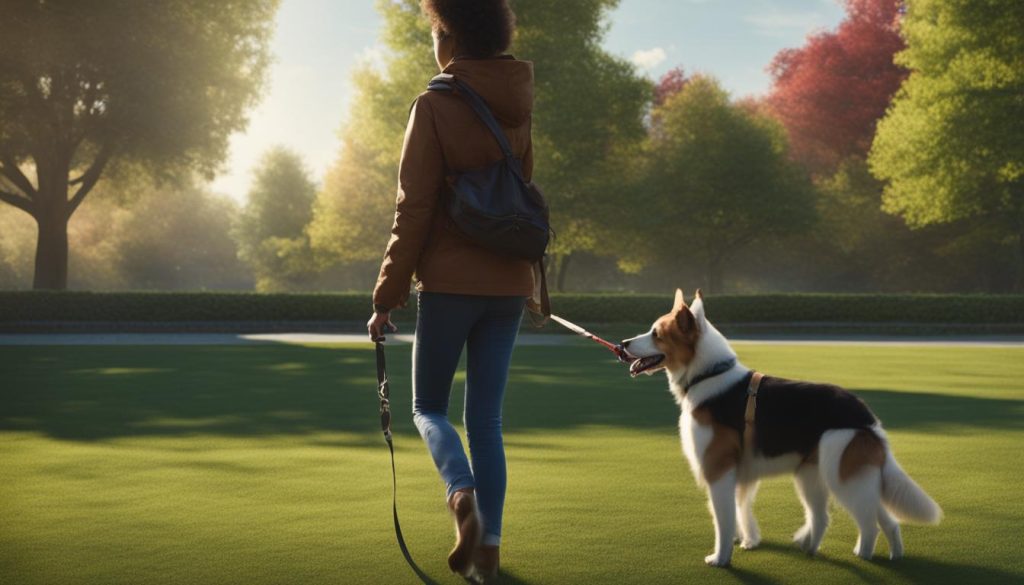
| Benefits of Heel Training | Challenges of Heel Training |
|---|---|
| Enhanced control during walks | The need for consistent practice |
| Improved responsiveness to commands | Distracting environments |
| Increased safety in crowded areas | Building endurance for longer walks |
| Strengthened bond between dog and owner | Mastering the correct heel position |
Recap and Next Steps
Leash training is a journey that requires patience, consistency, and positive reinforcement. By following the techniques and tips outlined in this article, you can teach your dog to walk on a leash without pulling. To put it simply, the goal is to achieve loose leash walking, where your dog walks calmly by your side without tugging or straining.
The Importance of Consistency
Consistency is key when it comes to leash training. Set aside dedicated training sessions each day and ensure that all family members involved in your dog’s care follow the same rules and techniques. This will help your dog understand what is expected of them and establish clear boundaries for leash walking.
The Power of Positive Reinforcement
Positive reinforcement is a powerful tool in leash training. Whenever your dog walks nicely on the leash without pulling, reward them with treats, praise, or playtime. This reinforces the desired behavior and encourages them to continue walking calmly by your side. Try to be patient and consistent with your rewards, as it may take time for your dog to fully grasp the concept of loose leash walking.
Gradually Increase Difficulty
Once your dog has mastered walking on a leash without pulling in a controlled environment, gradually introduce distractions and different environments. Start with low-distraction areas, such as your backyard, before moving on to busier streets or parks. This will help your dog generalize their leash walking skills and remain focused even in more challenging situations.
| Leash Training Tips | Loose Leash Walking Techniques | Dog Walking Techniques |
|---|---|---|
| Consistency is key | Use positive reinforcement | Gradually increase difficulty |
| Set clear boundaries | Be patient and consistent | Practice in different environments |
| Reward desired behavior | Use treats, praise, or playtime | Generalize leash walking skills |
Continued Practice and Reinforcement
Leash training is an ongoing process. Even after your dog has become proficient at walking on a leash without pulling, you should continue practicing and reinforcing the desired behavior. Regular training sessions, daily walks, and occasional refresher courses will help maintain your dog’s leash walking skills and strengthen the bond between you and your furry companion.
To put it simply, leash training should be a positive and enjoyable experience for both you and your dog. Celebrate small successes along the way and have patience during the learning process. With time and effort, you and your dog can enjoy pleasant and relaxing walks together, free from the frustration of pulling on the leash.
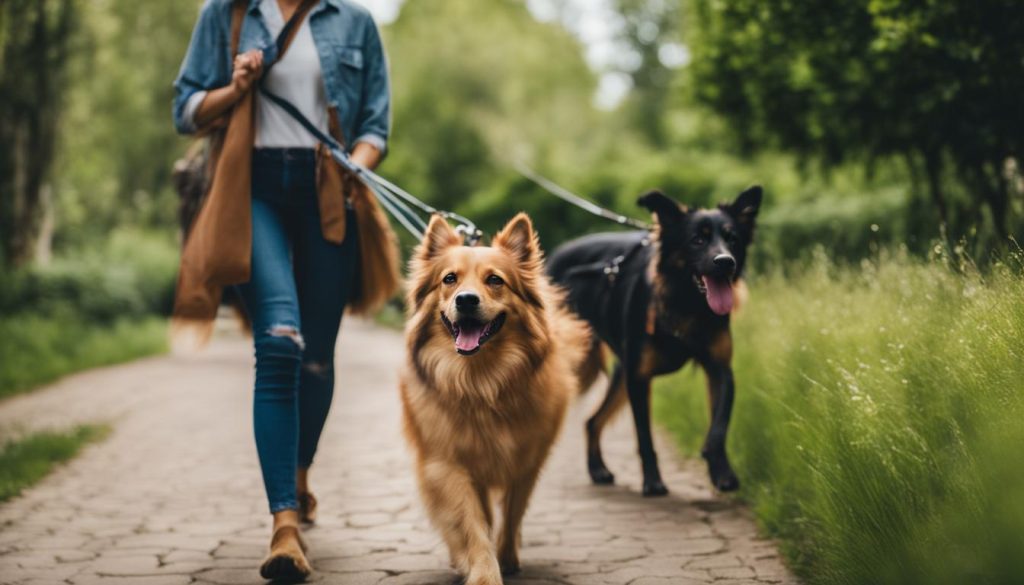
Final Thoughts
Leash training is a crucial aspect of dog ownership, and by using positive reinforcement techniques and the right equipment, you can teach your dog to walk on a leash without pulling. Throughout this article, we have explored various tips and strategies to help you achieve success in leash training.
To put it simply, patience and consistency are key when teaching your dog to walk nicely on a leash. Celebrate small victories along the way and be sure to provide ample rewards and praise to reinforce positive behaviors.
By following the step-by-step guide and utilizing reward-based training, you can create a stronger bond with your furry friend and enjoy pleasant and relaxing walks together. Leash training not only enhances safety and control but also provides a foundation for overall obedience and well-being.
So, embrace the journey of training and continue to practice in various environments. With time and effort, your dog will become a skilled and well-behaved companion on every leash walk.
FAQ
Why is leash training important for dogs?
Leash training is important for several reasons. It ensures the safety of your dog, provides a more enjoyable walking experience, and helps establish you as the leader and strengthen the bond between you and your dog.
What kind of leash walking equipment should I use?
You should choose equipment that is comfortable for your dog and does not cause any harm or discomfort. Options such as a front-attachment harness or head collar can discourage pulling and provide better control.
How do I use the stop and reward method for leash training?
When your dog pulls on the leash, you stop moving forward and wait for them to come back to your side. Once they are walking nicely by your side, you reward them with treats or praise to reinforce the desired behavior.
How can I leash train a puppy?
Start by attaching a long rope or leash to your puppy’s harness and reward them for walking by your side. Gradually decrease the length of the leash and continue to reward them for staying close to you. Practice in a familiar outdoor area and gradually introduce distractions to improve their leash walking skills.
How can I stop my dog from pulling on the leash?
When your dog starts pulling, change direction or stop to get their attention and encourage them to come back to your side. Reward them for walking without pulling and gradually increase the difficulty level by introducing more distractions. Consistency and positive reinforcement are key.
How can I distraction-proof my dog during walks?
Start by working with distractions at an intensity that your dog can handle, gradually increasing the difficulty level. Use rewards and positive reinforcement to encourage them to stay by your side even in the presence of distractions. Consistent practice and patience will help your dog become more reliable in different environments.
What is reward-based training for leash walking?
Reward-based training involves rewarding your dog with treats, praise, or toys when they exhibit positive behaviors, such as walking without pulling. Ignoring unwanted behaviors and redirecting their attention back to walking nicely reinforces good behavior and strengthens the bond between you and your dog.
What role does equipment play in leash training?
The right equipment, such as harnesses and head collars that discourage pulling, can be helpful tools in leash training. However, you should choose equipment that does not cause pain or discomfort to your dog.
How can I train my dog to heel?
Heel training involves teaching your dog to walk closely by your side. It requires similar techniques as loose leash walking, but with a focus on maintaining a specific position. Consistent training and reinforcement can help your dog learn to walk nicely on a leash in a heel position.
What are the next steps after leash training?
After leash training, continue to practice in various environments and celebrate small successes. Reinforce good behaviors, maintain consistency, and enjoy the pleasant and relaxing walks you can now have with your dog.


